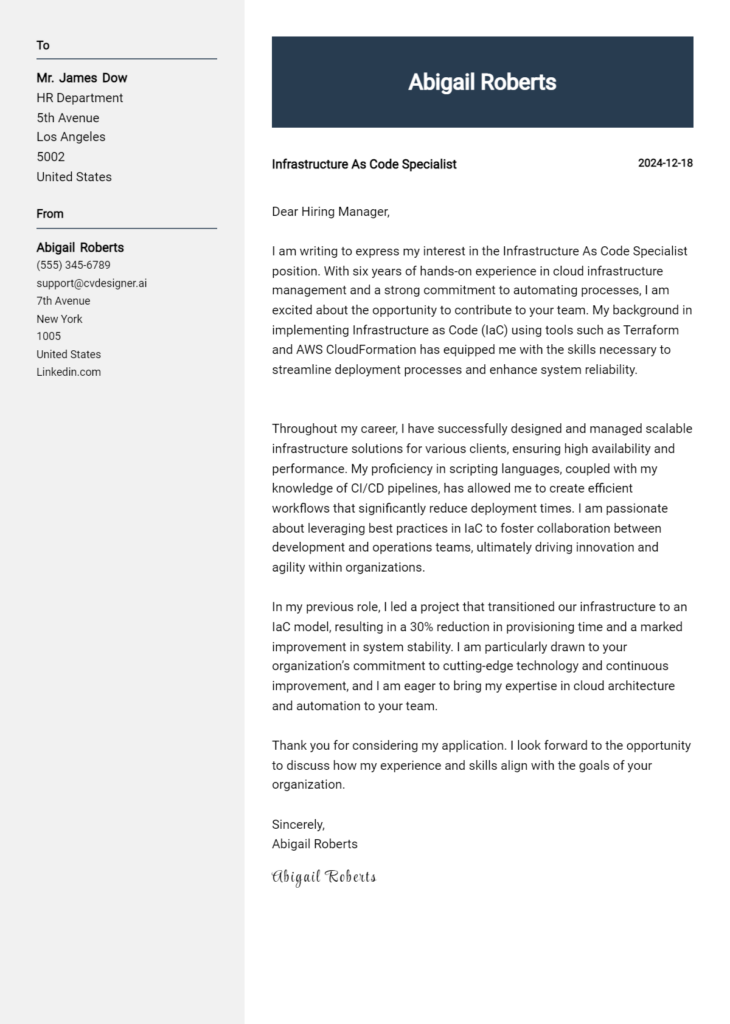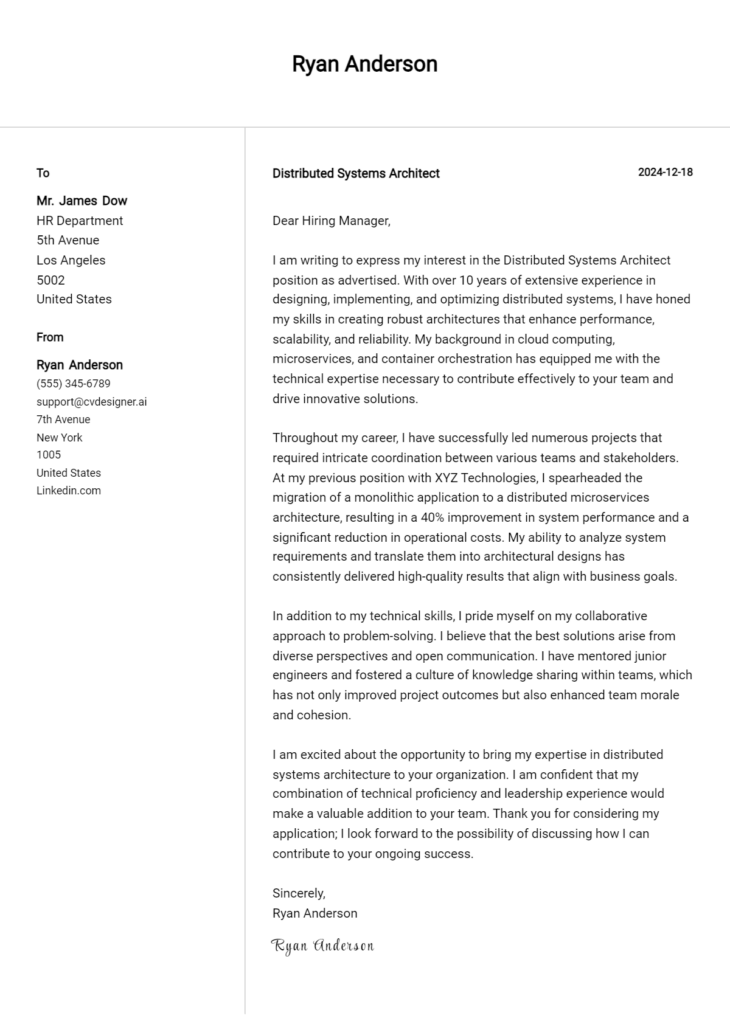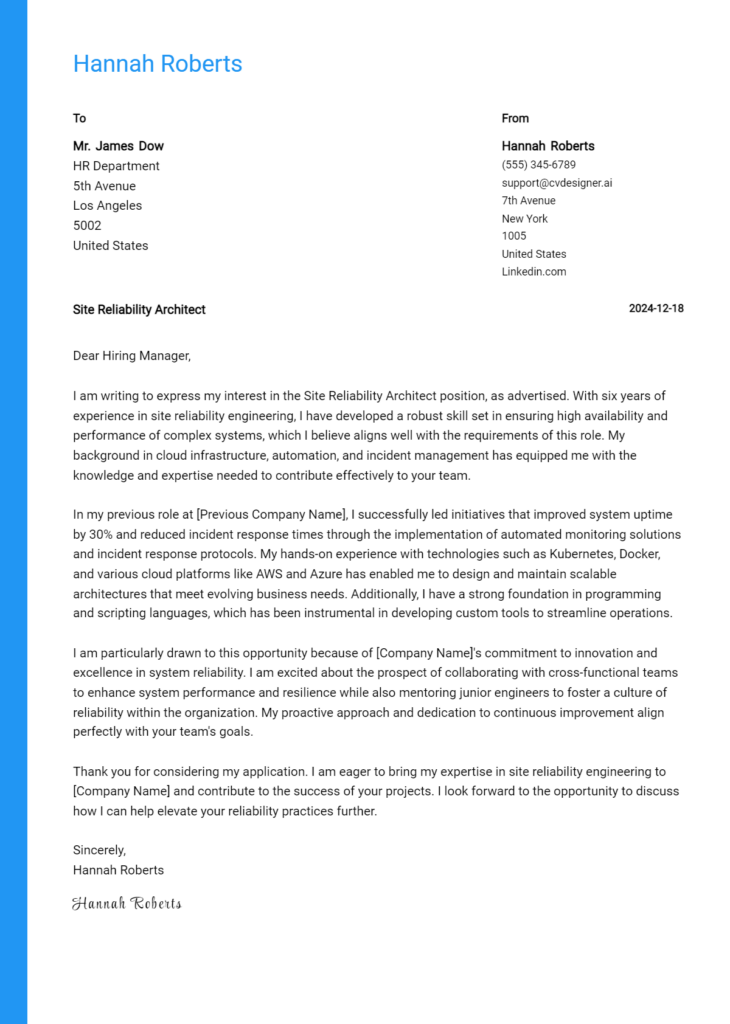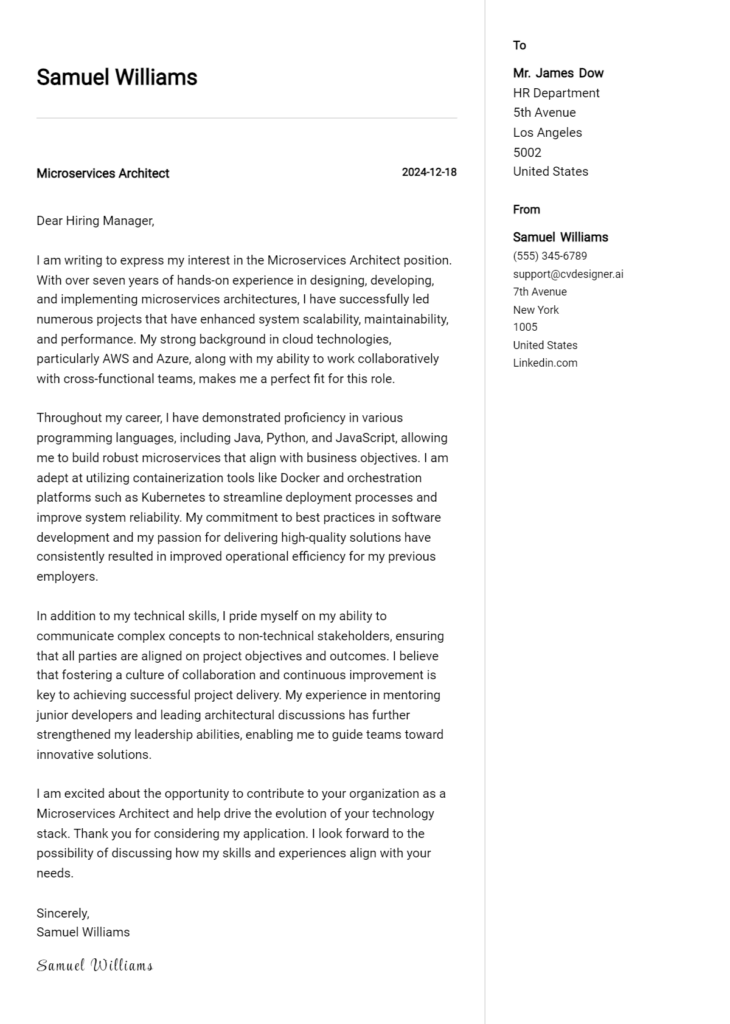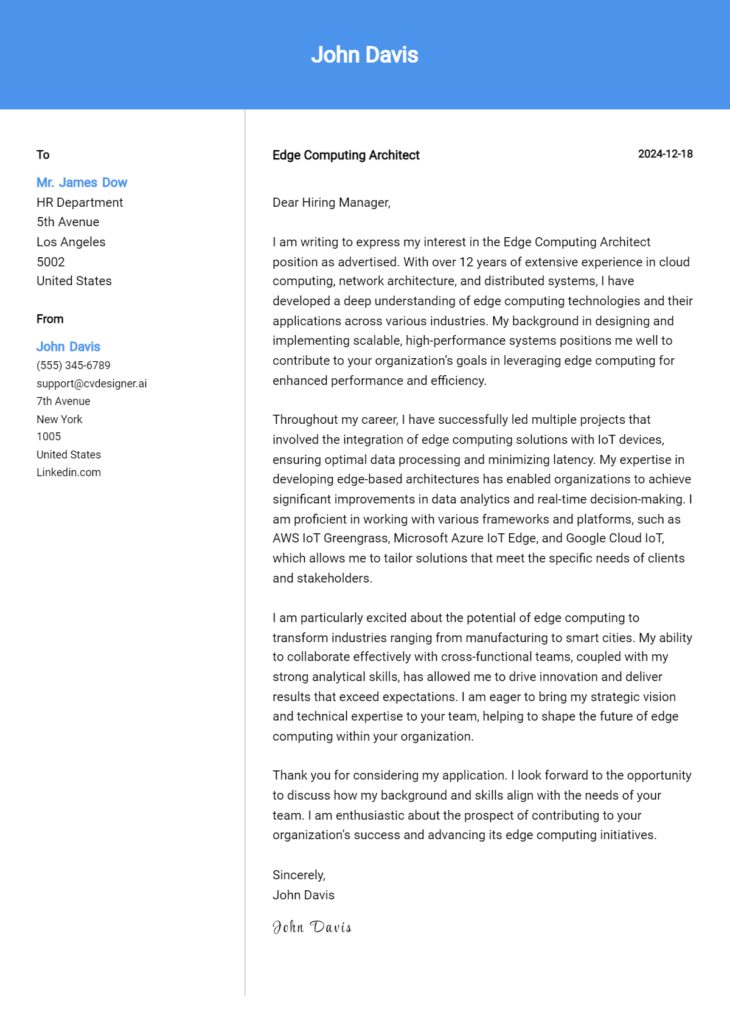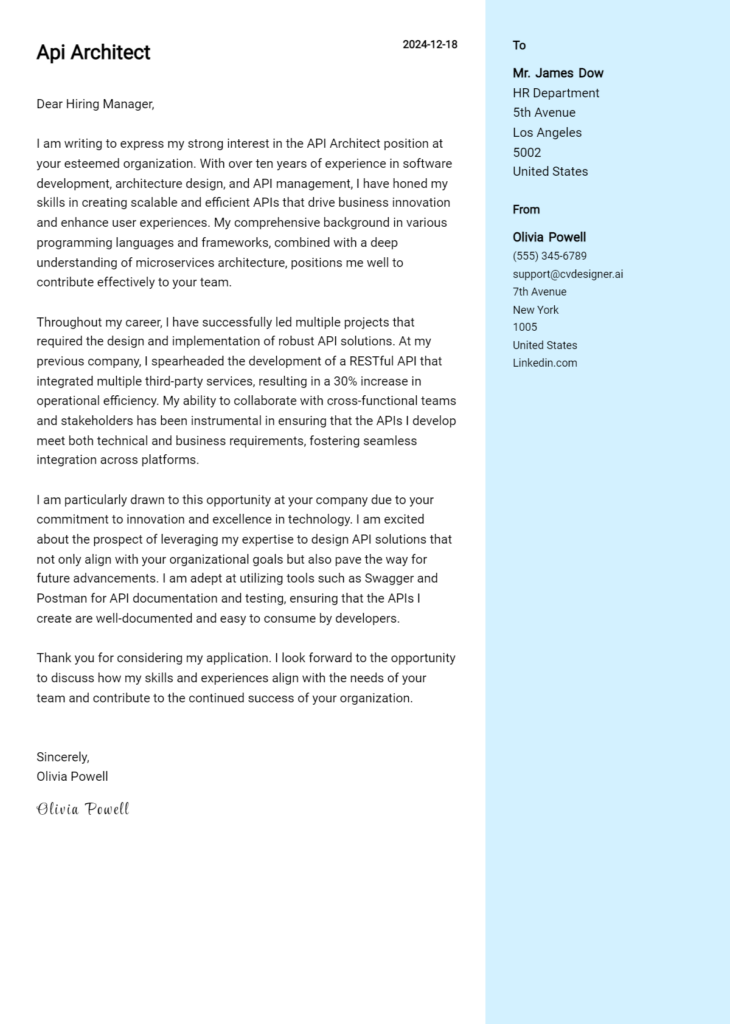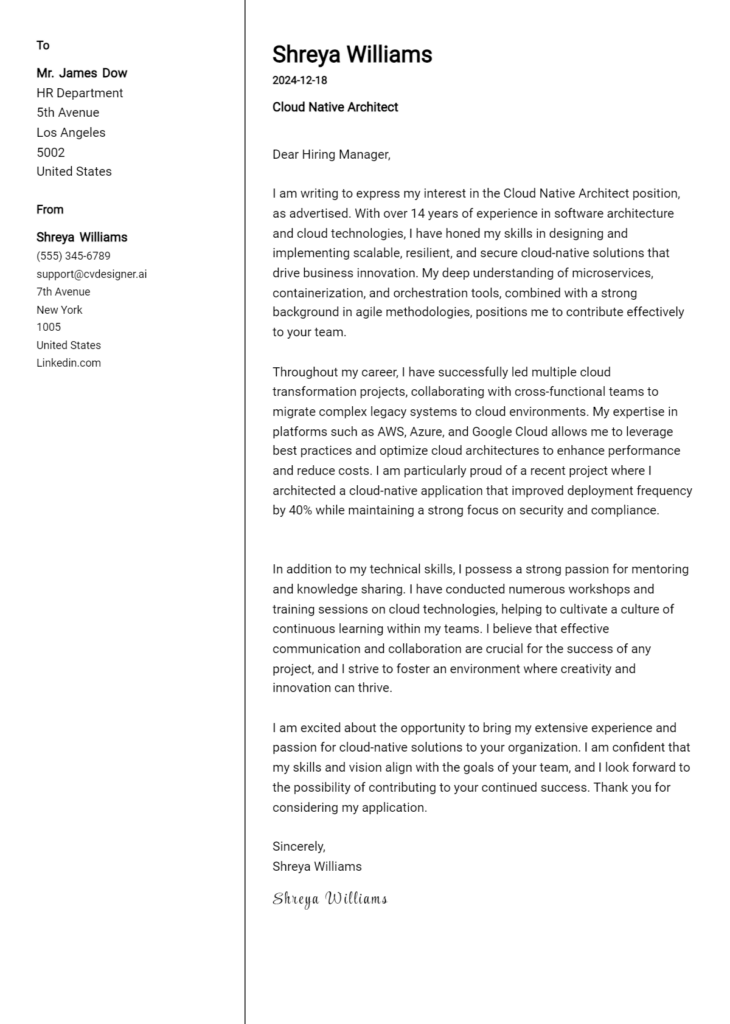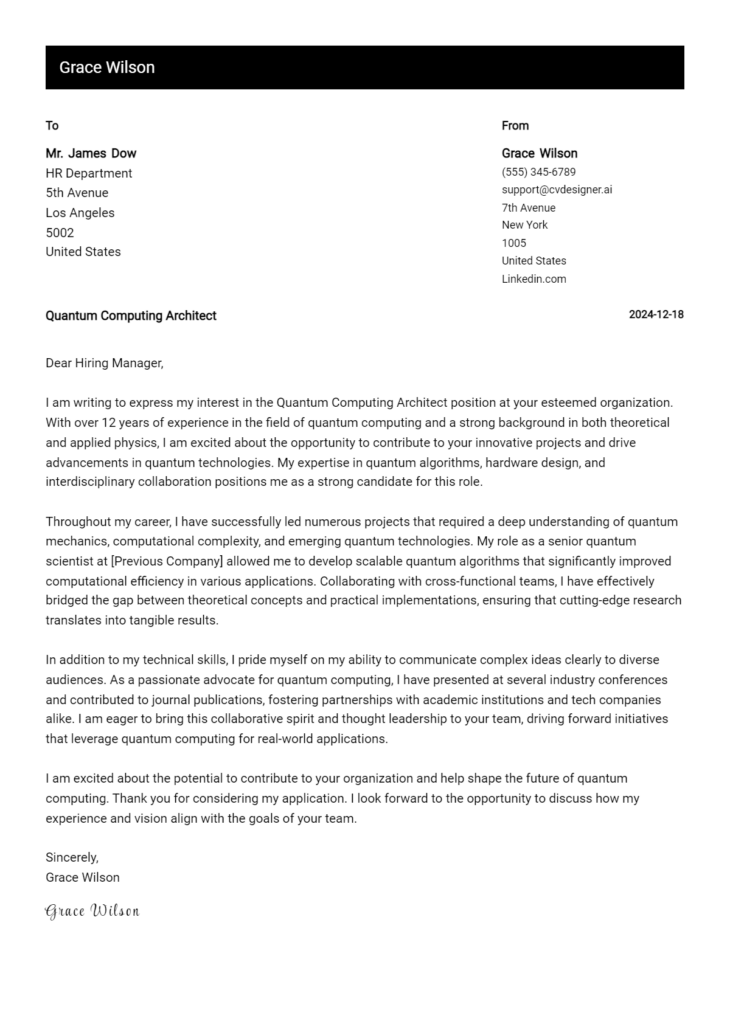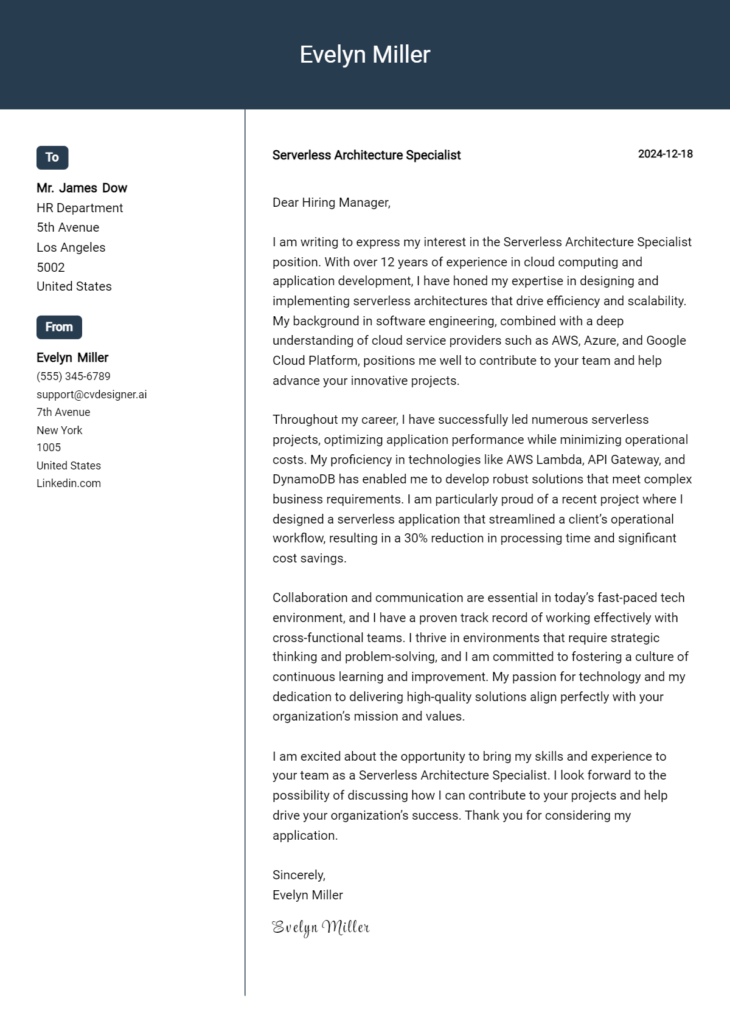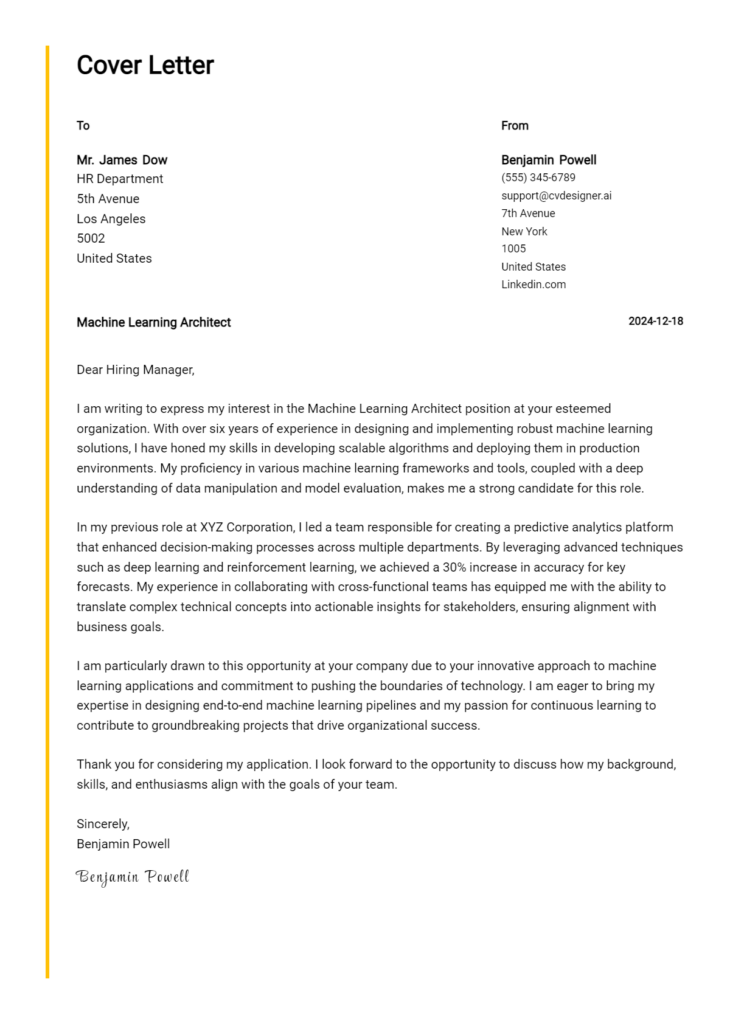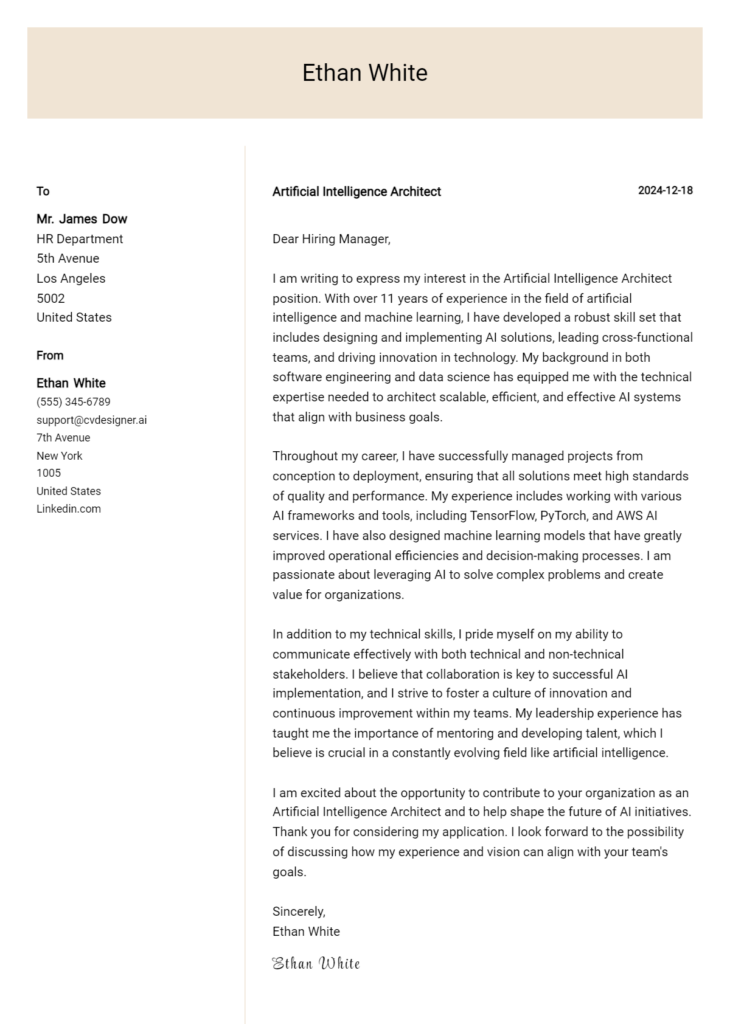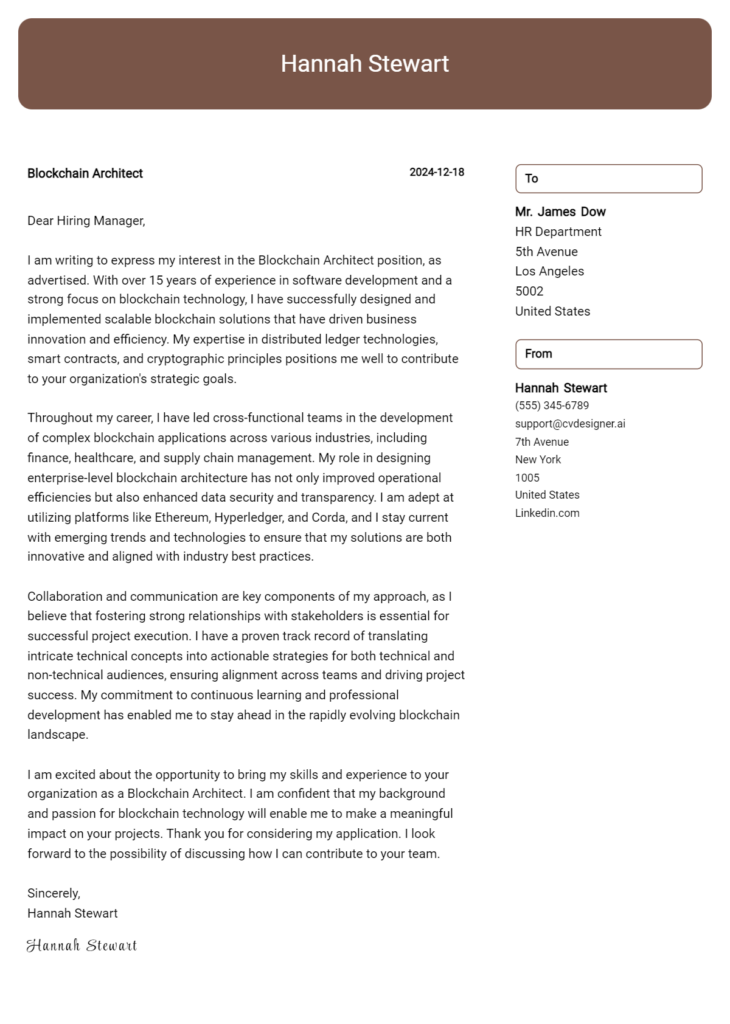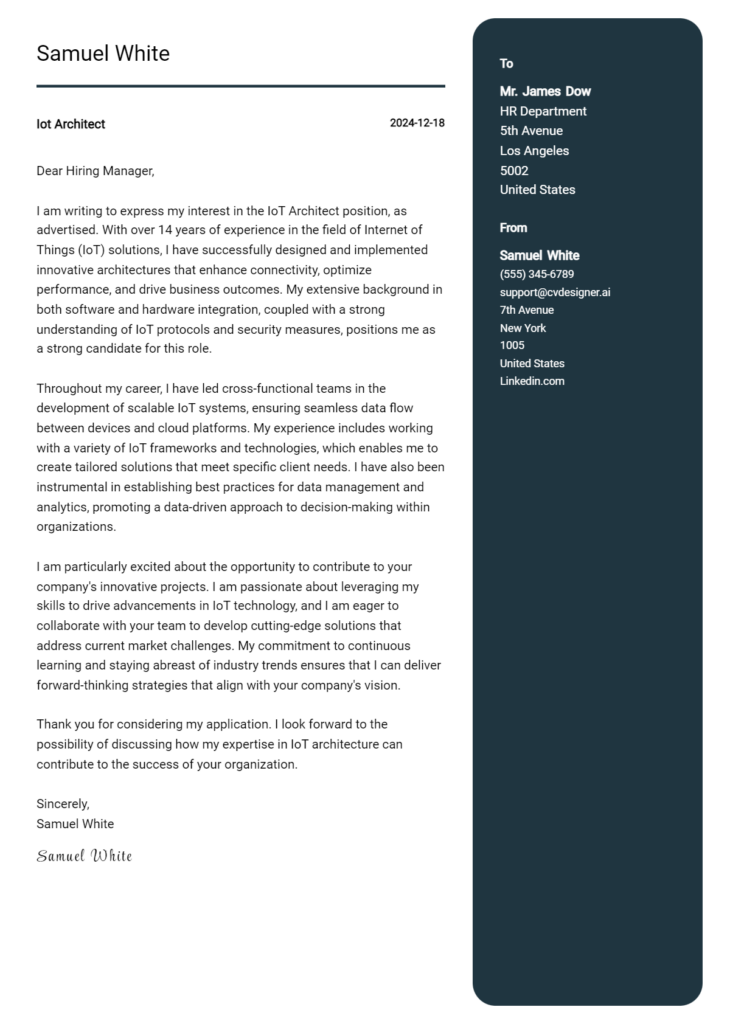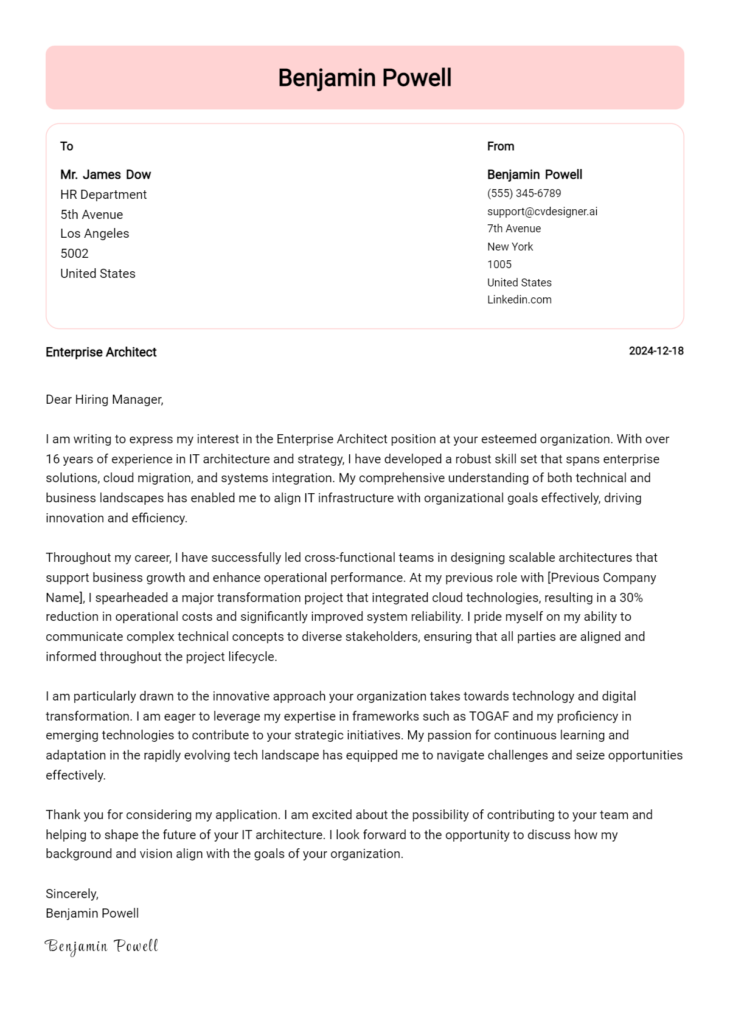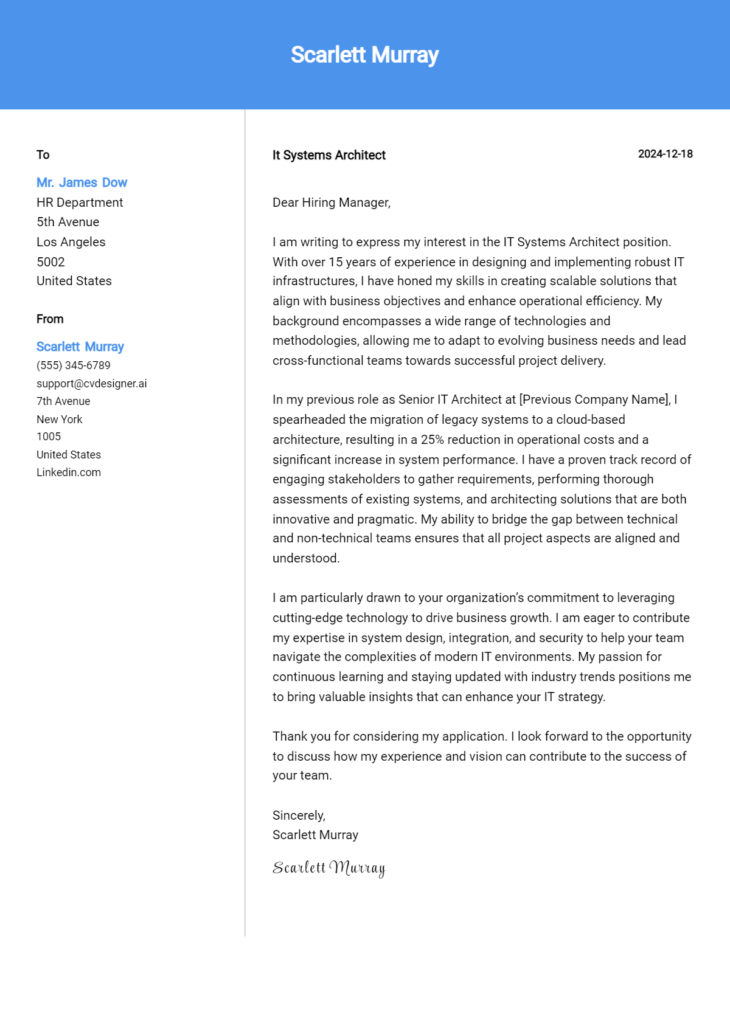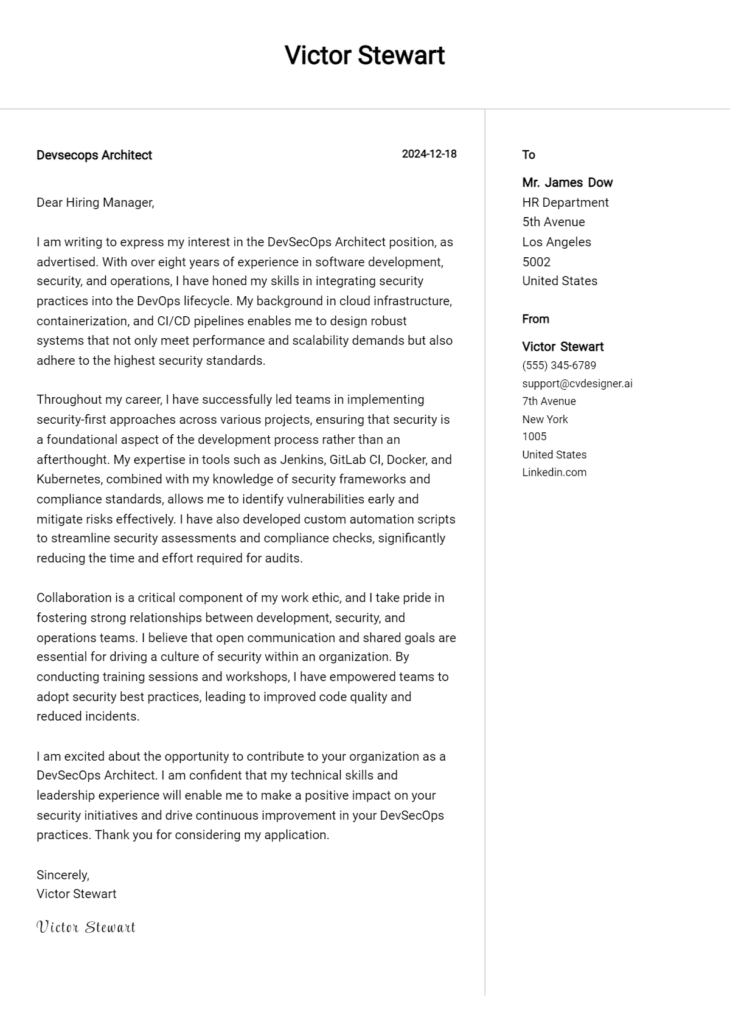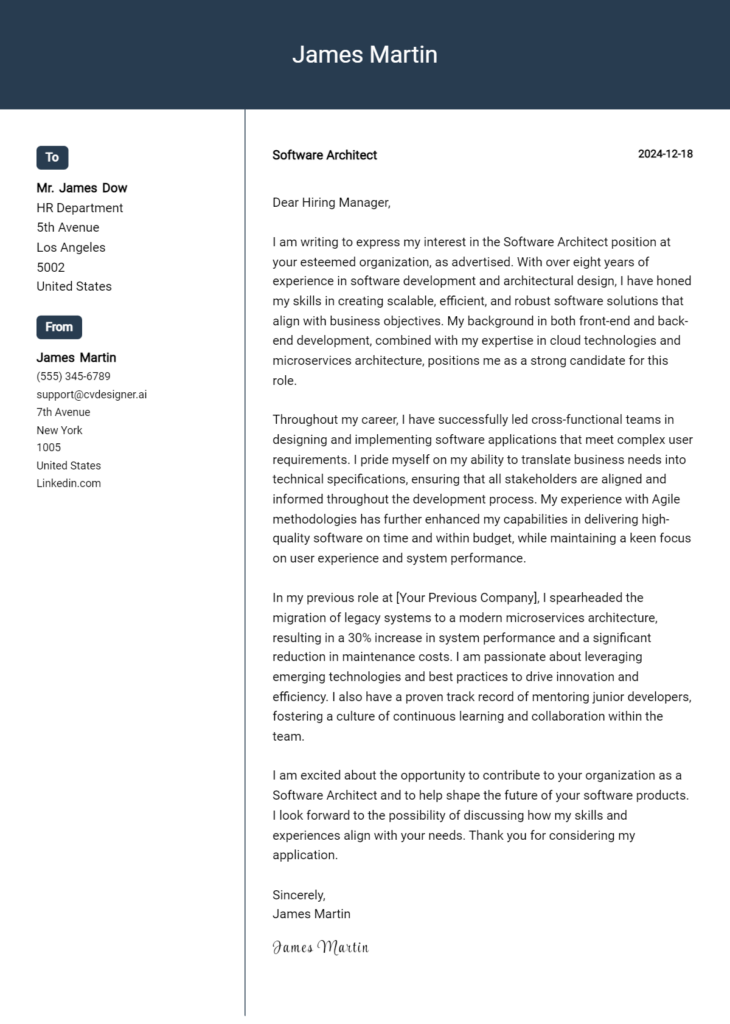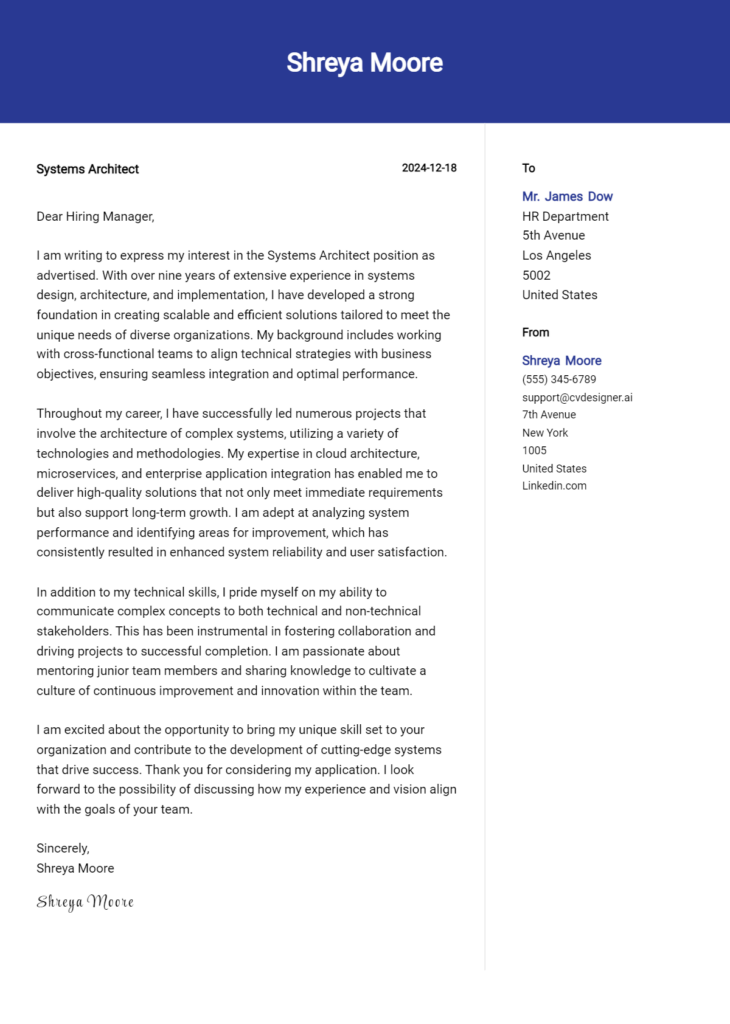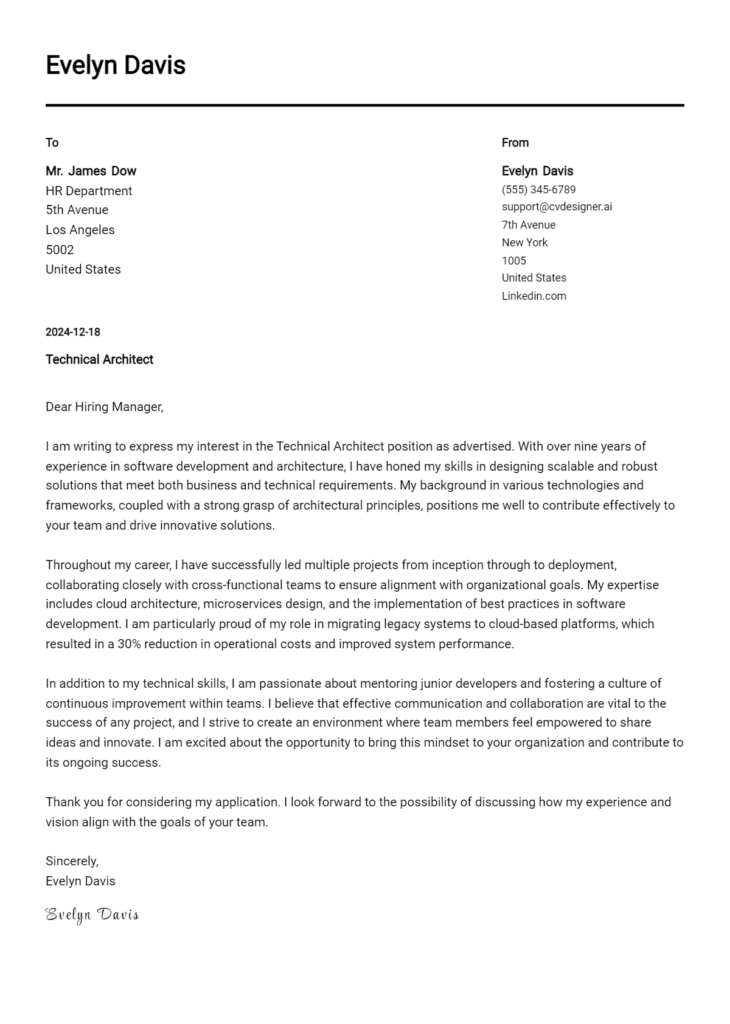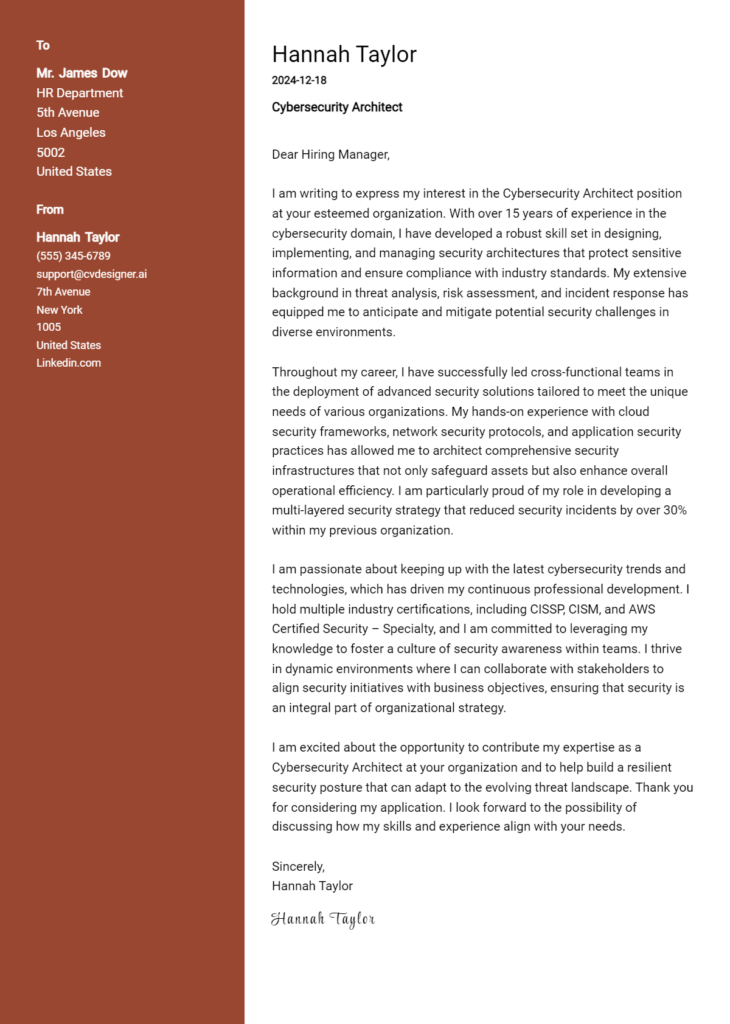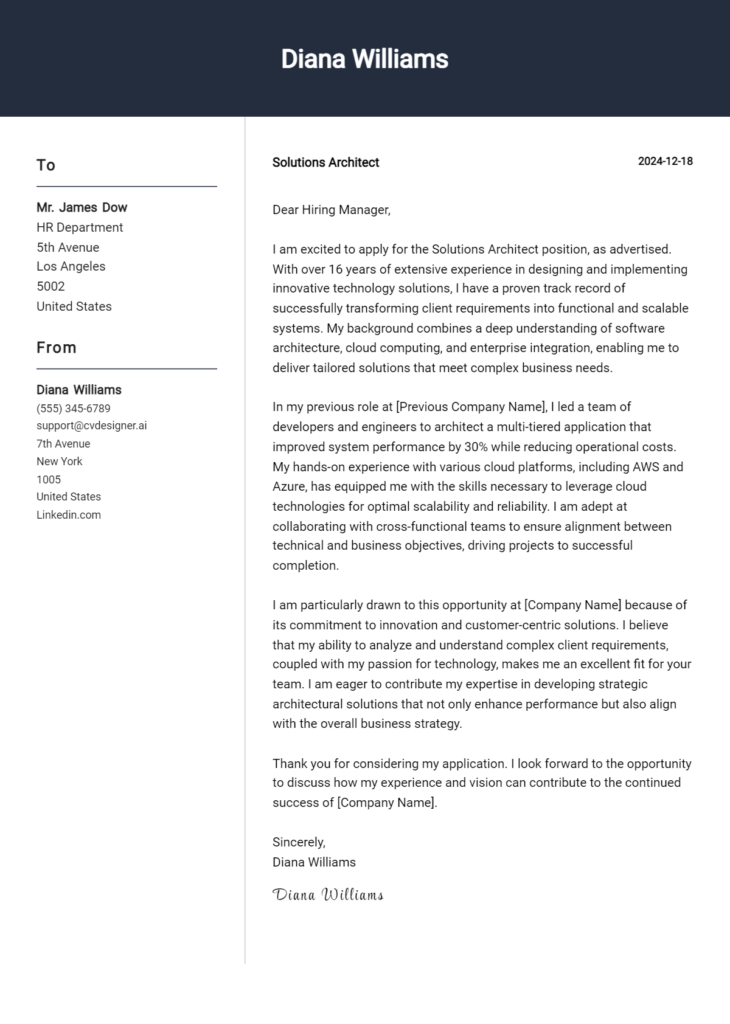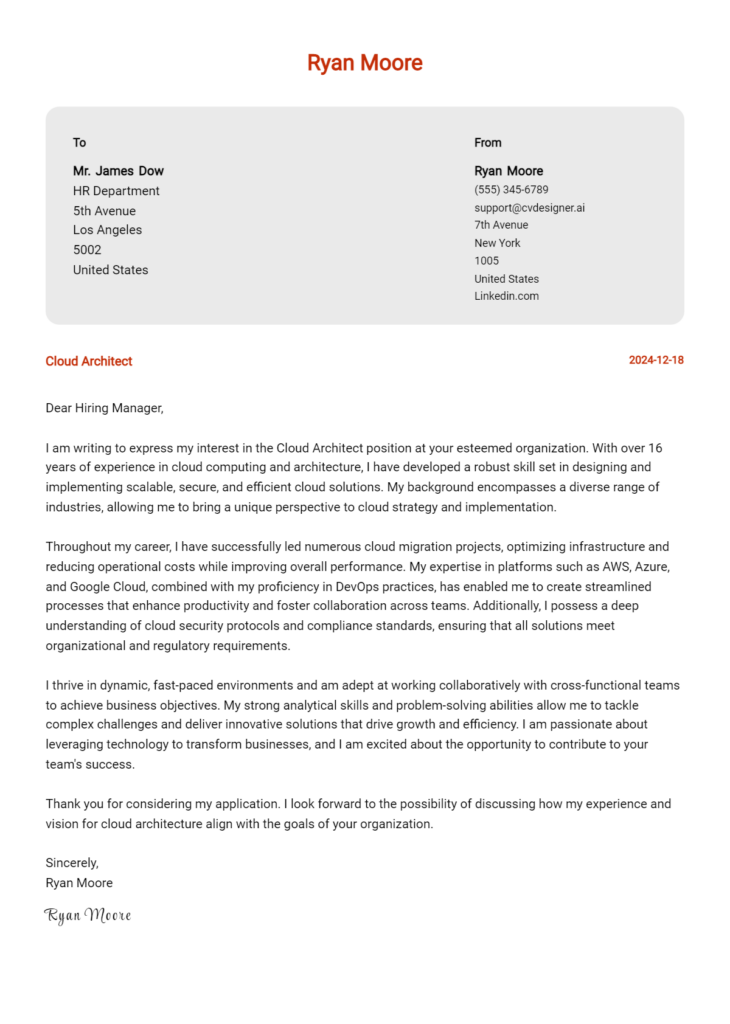Network Architect Cover Letter Examples
Explore additional Network Architect cover letter samples and guides and see what works for your level of experience or role.
How to Format a Network Architect Cover Letter?
Crafting an impactful cover letter is essential for a Network Architect, as it serves as your first opportunity to demonstrate your technical expertise and strategic thinking to potential employers. The way you format your cover letter not only reflects your communication skills but also showcases your ability to design and implement complex network solutions—a critical aspect of the role. A well-structured cover letter captures the hiring manager's attention while effectively conveying your qualifications and experience, key traits for a successful Network Architect.
In this guide, we'll explore how to structure your cover letter, providing insights and examples tailored for network architecture professionals.
We will focus on crucial components of a professional cover letter, including:
- Cover Letter Header
- Cover Letter Greeting
- Cover Letter Introduction
- Cover Letter Body
- Cover Letter Closing
Each section plays a vital role in showcasing your qualifications and professionalism. Let’s break down each part to ensure your Network Architect cover letter stands out.
Importance of the Cover Letter Header for a Network Architect
The cover letter header is a critical component of any professional correspondence, especially for a Network Architect. It sets the tone for the letter and provides essential information that helps potential employers identify who you are and how to contact you. A well-structured header includes your contact information, the date, and the recipient’s details, all presented in a clear and professional manner. Clarity in the header reflects your attention to detail—an essential trait for a Network Architect who must manage complex network infrastructures.
Below are examples of a strong and a weak cover letter header for a Network Architect position:
Strong Example
John Doe 123 Network Lane Tech City, CA 90210 (123) 456-7890 john.doe@email.com October 1, 2023 Jane Smith Hiring Manager XYZ Tech Solutions 456 Innovation Blvd Tech City, CA 90211
Weak Example
john doe tech city, ca 10/1/2023 jane smith xyz tech solutions
The Importance of a Cover Letter Greeting for a Network Architect
The greeting of your cover letter serves as the first impression to the hiring manager and sets the tone for the rest of your application. A well-crafted greeting demonstrates professionalism and shows that you have taken the time to personalize your approach, which can make a significant difference in a competitive job market. Addressing the hiring manager directly conveys respect and interest in the position, while generic greetings can come across as impersonal and uninspired. To avoid this pitfall, it's advisable to do a bit of research to find the name of the individual responsible for hiring, ensuring your greeting is specific and tailored to the recipient.
Strong Greeting Example
Dear Ms. Johnson,
Weak Greeting Example
To Whom It May Concern,
The Importance of a Compelling Cover Letter Introduction for a Network Architect
A well-crafted cover letter introduction is crucial for a Network Architect as it serves as the first impression to the hiring manager. This opening paragraph should grab attention and convey genuine interest in the role while succinctly highlighting the candidate's most relevant skills and achievements. A strong introduction not only piques the reader's curiosity but also sets the tone for the rest of the letter, making it essential for candidates to carefully construct this section. Below are examples of both a strong and a weak introduction to illustrate the difference.
Strong Example
Dear [Hiring Manager's Name], I am excited to apply for the Network Architect position at [Company Name], as I believe my extensive experience in designing and implementing scalable network infrastructures aligns perfectly with your team's needs. With over seven years in the industry, I have successfully led multiple projects that enhanced network performance by 30% and reduced downtime by 25%. My passion for innovative networking solutions motivates me to contribute to [Company Name]'s commitment to excellence in technology.
Weak Example
To Whom It May Concern, I am writing to express my interest in the Network Architect job you posted. I have worked in IT for several years, and I think I could do this job. I have some experience with networks, and I am looking for a new opportunity.
Purpose of the Cover Letter Body for a Network Architect
The body of a cover letter for a Network Architect serves as a crucial platform for candidates to articulate their technical skills, relevant experiences, and the unique value they can bring to the prospective employer. It is an opportunity to highlight specific projects or accomplishments that demonstrate their expertise in designing, implementing, and managing complex network infrastructures. By detailing past successes, such as optimizing network performance or enhancing security protocols, candidates can effectively convey their ability to contribute to the company's goals and objectives, making a compelling case for their candidacy.
Strong Example
In my previous role at TechVision, I successfully led a project to redesign the network architecture for a multi-site organization, which resulted in a 30% increase in data throughput and a 25% reduction in latency. Utilizing advanced routing protocols and implementing a robust security framework, I ensured seamless connectivity and enhanced data integrity across all locations. Additionally, my collaborative approach with cross-functional teams allowed us to complete the project three weeks ahead of schedule, significantly lowering operational costs and boosting client satisfaction.
Weak Example
I have worked in networking for several years and have done some projects. I know about routers and switches and can fix problems. I think I would be a good fit for your company because I like networking and want to help.
Importance of the Cover Letter Closing for a Network Architect
The closing paragraph of a cover letter is critical for leaving a lasting impression on potential employers. For a Network Architect, it should succinctly summarize qualifications, reaffirm enthusiasm for the position, and encourage the hiring manager to take the next step, whether that be reviewing the resume or scheduling an interview. A strong closing not only reinforces the candidate's fit for the role but also demonstrates professionalism and proactivity.
Strong Example
I am excited about the opportunity to bring my extensive experience in designing and optimizing network infrastructures to your esteemed organization. With my proven track record of successful implementations and a passion for innovative network solutions, I am confident in my ability to contribute effectively. I would appreciate the chance to discuss my application further and explore how I can support your team’s goals. Thank you for considering my application; I look forward to the possibility of discussing this exciting opportunity with you.
Weak Example
Thank you for reading my letter. I hope you look at my resume. I think I would be okay for this job. Please let me know what you think.
These tips will guide candidates in crafting an effective cover letter for a Network Architect position, emphasizing the need to highlight their technical skills, problem-solving abilities, knowledge of the Software Development Life Cycle (SDLC), teamwork capabilities, and a commitment to continuous learning. A well-structured cover letter not only showcases your qualifications but also reflects your passion for the field, making you a strong candidate for the role.
Tips for Writing an Effective Cover Letter for a Network Architect
Showcase Your Technical Skills: Clearly outline your technical proficiencies relevant to the Network Architect role. Include specific technologies, protocols, and tools you are familiar with, such as TCP/IP, VPNs, firewalls, and network configuration. This not only demonstrates your expertise but also shows that you are well-prepared for the technical demands of the job.
Highlight Problem-Solving Abilities: Provide examples of complex network issues you have resolved in the past. Use the STAR method (Situation, Task, Action, Result) to clearly articulate your problem-solving process. This helps the employer see your analytical thinking and ability to overcome challenges, which are crucial for a Network Architect.
Demonstrate SDLC Knowledge: Discuss your understanding of the Software Development Life Cycle and how it relates to network architecture. Mention instances where you have collaborated with developers and project managers to ensure that network solutions align with overall project goals. This shows that you can work effectively in a cross-functional team environment.
Emphasize Teamwork and Collaboration: Network Architects often work in teams, so it's essential to highlight your experience working collaboratively with others. Share examples of successful group projects and your role within those teams. This can illustrate your interpersonal skills and how you contribute to achieving common objectives.
Express Your Passion for Continuous Learning: The tech industry is constantly evolving, and showing your commitment to staying current with emerging technologies can set you apart. Mention any relevant certifications, courses, or professional development activities you are pursuing. This conveys to potential employers that you are proactive in enhancing your skills and knowledge, making you a valuable asset to their organization.
For additional resources to help you craft your cover letter, consider exploring cover letter templates or using a cover letter builder for a more tailored approach.
Common Mistakes to Avoid in a Network Architect Cover Letter
Crafting a compelling cover letter is essential for a Network Architect position, as it serves as your first impression to potential employers. To stand out, it's vital to avoid common pitfalls that can undermine your application. Here are some frequent mistakes and tips on how to steer clear of them:
Generic Opening: Using a generic salutation like "To Whom It May Concern" can make you seem uninterested. Research the hiring manager's name and address them directly.
Lack of Specificity: Failing to mention specific skills or experiences relevant to the role can weaken your case. Tailor your cover letter by highlighting your expertise in network design, security, or cloud technologies.
Overly Technical Language: While technical skills are crucial, using overly complex jargon may alienate non-technical readers. Strive for clarity and balance between technical details and accessible language.
Ignoring the Job Description: Many applicants overlook the importance of aligning their cover letter with the job description. Carefully read the requirements and incorporate relevant keywords to demonstrate your fit.
Failure to Show Value: A common mistake is merely listing duties from past roles rather than showcasing accomplishments. Use metrics to illustrate how your contributions improved network performance or reduced downtime.
Neglecting Formatting: A cluttered or unprofessional layout can distract from your message. Follow a clear cover letter format that enhances readability and professionalism.
Typos and Grammatical Errors: These mistakes can signal a lack of attention to detail. Always proofread your cover letter, or consider using tools to check for errors before submission.
By being mindful of these common mistakes, you can create a strong cover letter that effectively showcases your qualifications and sets you on the path to success. For inspiration, explore cover letter examples to see what works best in your field.
Cover Letter FAQs for Network Architect
What should I include in my cover letter as a Network Architect?
In your cover letter, emphasize your expertise in network design and architecture, including specific technologies you've worked with, such as MPLS, SDN, or cloud networking. Highlight your experience in managing complex network infrastructures and your ability to assess and mitigate security risks. Include examples of successful projects where you improved network efficiency or reduced costs. Mention relevant certifications like CCNA, CCNP, or CCIE, as they validate your skills. Additionally, articulate your understanding of the business impact of networking decisions, demonstrating that you can align technical solutions with organizational goals.
How can I demonstrate my technical skills in the cover letter?
To effectively showcase your technical skills, use specific examples and metrics in your cover letter. For instance, describe a project where you designed a scalable network solution that resulted in a 30% increase in bandwidth efficiency or minimized downtime. Mention the tools and technologies you utilized, such as network simulation software or monitoring tools. Additionally, incorporate industry terminology to demonstrate your familiarity with current trends and standards. This not only illustrates your technical capabilities but also shows you can communicate complex concepts clearly, a critical skill for a Network Architect.
Should I tailor my cover letter for each job application?
Absolutely, tailoring your cover letter for each job application is crucial. Different companies may focus on various aspects of network architecture, from cloud solutions to cybersecurity. Research the organization’s network needs and specific technologies they use, then align your experience and skills with those requirements. For instance, if the company emphasizes a need for expertise in cloud networking, highlight your relevant experience in that area. Personalizing your cover letter shows that you’ve taken the time to understand the role and the company, which can set you apart from other candidates.
How long should my cover letter be?
Your cover letter should ideally be one page long, which typically translates to about 300-400 words. It should be concise yet comprehensive enough to cover your relevant experience, technical skills, and enthusiasm for the position. Aim to keep paragraphs brief, using bullet points if necessary to enhance readability. A well-structured cover letter allows hiring managers to quickly skim and find key information. Remember, the goal is to entice the reader to learn more about you during the interview, so focus on quality over quantity while maintaining a professional tone.
Build your Cover Letter in minutes
Use an AI-powered cover letter builder and have your letter done in 5 minutes. Just select your template and our software will guide you through the process.


